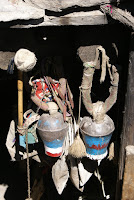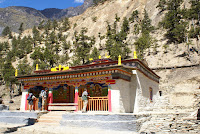
After having bought some souvenirs, the next day we leave for Pokhara. All porters, kitchen crew and guides are stuffed into our bus. Never a dull moment on this trip, especially because we enjoy al kinds of Bollywood productions on the mini-tv screen in the bus. I find it hillarious, all those dancing people with toothpaste-white smiles. Cannot stop smiling.

 Pokhara is nice and relaxing. We have a cosy hotel and look forward to our return in about 4 weeks. We now know where the good food is! The next day, a little mini-van is waiting for us. He will take us to Beni and maybe to Babichaur, the first camp site. We are told there is a road now all the way up to Babichaur. It's quite hot and the mini van appears a bad choice. Due to rainfall, the road is slippery and there are a lot of potholes. As a result, the van is stuck. That means: go for a walk. Our first walk is a tough one: we have to get used to the warm climate during the hottest hours of the day. Luckily, our guide arranges a jeep that brings us to the first campsite.
Pokhara is nice and relaxing. We have a cosy hotel and look forward to our return in about 4 weeks. We now know where the good food is! The next day, a little mini-van is waiting for us. He will take us to Beni and maybe to Babichaur, the first camp site. We are told there is a road now all the way up to Babichaur. It's quite hot and the mini van appears a bad choice. Due to rainfall, the road is slippery and there are a lot of potholes. As a result, the van is stuck. That means: go for a walk. Our first walk is a tough one: we have to get used to the warm climate during the hottest hours of the day. Luckily, our guide arranges a jeep that brings us to the first campsite.  In 2000, our Dhaulagiri trekking started here as well. The campsite is very the same. After a hot night, the next morning we start walking the 'highway'. Nine years ago, there was no road at all. Today, several cars and busses are passing by. GRMBL. At the end, we leave the beaten track and must climb to our next destination: Dharepani (1550m). This village has an amazing camp site; when the sky is clear, you can see the white covered summits of the Dhaulagiri range. Rick brought a small rugby ball and soon we are playing with all kitchenboys. Some of them trow the ball like a madman; my hands are all red and burning! The first contact with our staff is always nice. Now, they are still strangers for us, but at the end of our trip, we will be best friends. That's for sure!
In 2000, our Dhaulagiri trekking started here as well. The campsite is very the same. After a hot night, the next morning we start walking the 'highway'. Nine years ago, there was no road at all. Today, several cars and busses are passing by. GRMBL. At the end, we leave the beaten track and must climb to our next destination: Dharepani (1550m). This village has an amazing camp site; when the sky is clear, you can see the white covered summits of the Dhaulagiri range. Rick brought a small rugby ball and soon we are playing with all kitchenboys. Some of them trow the ball like a madman; my hands are all red and burning! The first contact with our staff is always nice. Now, they are still strangers for us, but at the end of our trip, we will be best friends. That's for sure! The next morning it's is again bloody hot. It's early (September) and you can feel that. But: no compaints, because there was a chance we would meet the monsoon. After Muna, we enter an unknown area. During the regular Dhaulagiri trekking, you turn right. Now we go to the left, to Lulang (2155m). Our campsite is in the village center and a lot of children are surrounding us, yelling: "gimme pen, gimme sweet".
The next morning it's is again bloody hot. It's early (September) and you can feel that. But: no compaints, because there was a chance we would meet the monsoon. After Muna, we enter an unknown area. During the regular Dhaulagiri trekking, you turn right. Now we go to the left, to Lulang (2155m). Our campsite is in the village center and a lot of children are surrounding us, yelling: "gimme pen, gimme sweet". The next day, a tough climb is awaiting for us. My mum arleady warned us (she and my dad walked the Dolpo trekking more than 10 years ago). In her memory, it was a never-ending, awful climb.
She was right.
 It is a climb of more then 1200 meters and it's very, very hot. We have to get used to it and it's not easy. Rick's leg is painful and that certainly influences our mood. The ongoing pressure on his right leg is a bit too much. On his own pace, he scrambles to the top. Higher on the hill, the path looks dampy and a bit spooky. I'm walking all alone and that is a somewhat scary experience. There are leeches everywhere: when you want to pee, they immediately crawl towards your unprotected areas. At the last stop, Rick joins me and together we walk the last bit. The Jalja La pass is beautiful (3380m). It's cloudy, but this flat, swamp-like area is a great camping place.
It is a climb of more then 1200 meters and it's very, very hot. We have to get used to it and it's not easy. Rick's leg is painful and that certainly influences our mood. The ongoing pressure on his right leg is a bit too much. On his own pace, he scrambles to the top. Higher on the hill, the path looks dampy and a bit spooky. I'm walking all alone and that is a somewhat scary experience. There are leeches everywhere: when you want to pee, they immediately crawl towards your unprotected areas. At the last stop, Rick joins me and together we walk the last bit. The Jalja La pass is beautiful (3380m). It's cloudy, but this flat, swamp-like area is a great camping place.











































